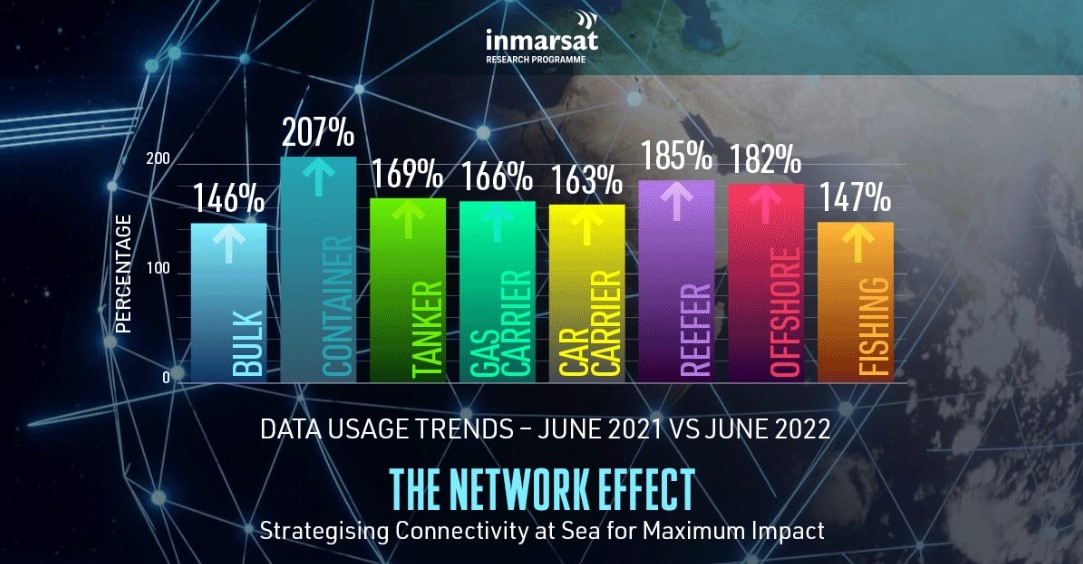A new report called “The Network Effect: Strategising Connectivity at Sea for Maximum Impact”, compiled by maritime innovation consultancy Thetius, and published by Inmarsat, makes a compelling case that shipping companies seeking to meet current and emerging challenges facing the maritime industry will benefit from a strategic approach to connectivity.
The Network Effect details the business benefits and specific capabilities that shipping companies can access by applying an effective connectivity strategy across their business IT, crew, and operational networks.
These include voyage and port-call optimisation, emissions reduction, condition monitoring and condition-based maintenance, trade facilitation, seafarer welfare and training, remote surveys and pilotage and telemedicine services.
Simply purchasing data is no longer enough. If shipowners are to reap the full rewards of operational optimisation, decarbonisation and a loyal and talented crew the right connectivity strategy is essential
warned Matthew Kenney, Director of Research and Consulting, Thetius.
According to the report, once a shipping company has established its objectives and identified the capabilities needed to achieve them, it will benefit most from finding the right combination of communication services to best support those capabilities.
By joining the dots between business goals and connectivity options, operators gain access to a host of benefits including opportunities to:
- Optimise and drive efficiency
- Reduce running costs
- Improve profit margins
- Attract and retain talented crew
- Future-proof operations
- Build in competitive advantages
Ultimately, a good connectivity strategy relies on a clear understanding of the company’s business goals, the technologies needed to attain those goals, and any additional influencing factors such as resource availability and investment requirements
Ben Palmer, President, Inmarsat Maritime, said.
 Recommendations
Recommendations
#1 Put cyber security at the centre: Consider the segregation of networks according to dedicated user segments: Commercial/IT for Business, Technical/OT and Crew/IT for Crew. Cyber security hygiene is vital. Put in place hard limits in terms of connectivity access – humans are often the weakest link in terms of cyber security.
#2 Build a data management system:
- In data collection and reporting applications, data quality should be controlled at the source
- Focus on the data model being the foundational component of developing a database. This will affect how an organisation will be able to use and scale their data.
- Ensure consistent data exchange standards – formats, capabilities, and limitations in sharing data through different platform providers.
#3 Business networks: Consider creating a dedicated network for critical and noncritical commercial uses:
- Critical use case – i.e. financial and regulatory reporting applications
- Non-critical use case – i.e. daily condition reporting
- Build a strategy that allows for continuous and proactive monitoring of digital activities aboard ship
- Review all forms of software being used and ensuring high levels of cyber security hygiene by changing passwords at set intervals and controlling user permissions – prior to installation, updating, and uninstallation
- Establish a dedicated and independent team to monitor potential illicit digital activities
- Create a dedicated and secure interface for client-related data (including multiple user redundancies – confirmations, restricted access, reported movement)
#4 The crew network: Establish a responsible Internet usage policy and proper cyber security hygiene:
- Scheduled password changes, consistent cyber security training and drills onboard
- Establish restrictions on certain websites that can infiltrate network systems
#5 Operational technology networks and emerging capability:
- Create secure and segmented networks with physical access redundancies and boundary protection measures
- Ensure secure one-to-one data collections
- Review all forms of software being used and ensuring high levels of cyber security hygiene by changing passwords at set intervals and controlling user permissions
- Establish a dedicated and independent team to monitor potential illicit digital activities
- Create a dedicated and secure interface for operational data

































































